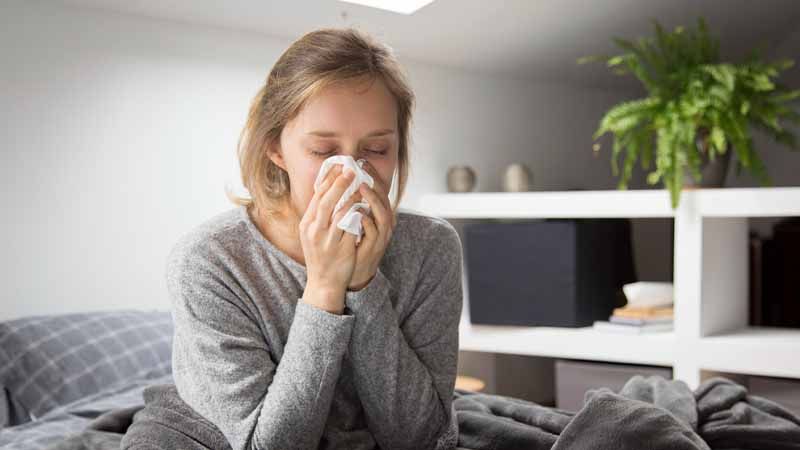The H3N2 influenza virus is a kind of influenza A virus that can cause respiratory illness in people. It is often referred to as the Hong Kong flu because it was identified in Hong Kong in 1968. H3N2 is a subtype of the Influenza A virus, one of the three main types of influenza viruses that cause seasonal flu. So far, 500 cases have been reported in India.
What is the H3N2 virus?
H3N2 is a highly contagious virus that spreads through respiratory droplets when an infected person talks, coughs, or sneezes. The virus can also survive on surfaces for several hours, so it is essential to maintain good hygiene, such as washing hands frequently and avoiding touching the face, to reduce the risk of infection.
In some cases, H3N2 infection can lead to more severe illness, especially in old people, young children, and people with underlying health conditions.
[Keep an eye out for other seasonal allergy]
What are the symptoms of H3N2?
The symptoms of H3N2 flu are similar to other types of flu and may include-
- Fever: H3N2 flu may cause a sudden high fever, typically above 100.4°F (38°C).
- Body aches: This flu can cause severe body aches, including headaches, joint pain, and muscle pain.
- Cough: A dry or productive cough (wet cough with mucus) is another common symptom of H3N2 flu.
- Sore throat: H3N2 flu can also cause a sore throat, especially in the early stages of the illness.
- Fatigue: You may feel tired and have difficulty performing your usual activities.
- Runny or stuffy nose: Some people with H3N2 flu may experience a runny or stuffy nose.
- Chills: H3N2 flu may cause chills, especially when you have a fever.
- Nausea and vomiting: Some people may experience gastrointestinal symptoms, such as nausea and vomiting.
Which age group is more vulnerable?
People of all ages can become infected with the H3N2 virus, but some age groups may be more vulnerable to severe illness and complications than others. Generally, older adults, young children, and people with underlying medical conditions are more likely to develop severe illness or complications from the H3N2 virus.
Adults over the age of 50 are at particular risk of developing complications such as pneumonia, bronchitis, and other respiratory infections. Young children, especially those under the age of 15, may also be at increased risk of developing severe illness from the H3N2 virus.
People with underlying medical conditions, such as asthma, diabetes, heart disease, or weakened immune systems, are also more vulnerable to H3N2 virus complications. These conditions may make it harder for the body to fight off the virus and increase the risk of developing pneumonia or other secondary infections.
[Also check: Ways to boost your immune system]
Do’s and Don’ts of the H3N2 virus
Do’s
- Maintain hand hygiene: Washing your hands frequently with soap and water is one of the most effective ways to prevent the spread of germs and infections. Wash your hands before and after eating, using the toilet, blowing your nose, coughing, or sneezing, and touching surfaces in public places.
- Avoid crowded places; it is still advisable to use a face mask: When there is a risk of infection, it is best to avoid crowded places where people are close together, as this increases the chance of transmission.
- Cover your mouth and nose when you sneeze or cough: When you cough or sneeze, cover your mouth and nose with a tissue or the crook of your elbow. It can help to prevent the spread of droplets that may contain the virus.
- Keep yourself hydrated by drinking plenty of fluids: Drinking plenty of fluids can help to keep your body hydrated, which is essential for maintaining good health.
- Consult a doctor: If you have a fever or body aches or experience any other symptoms, consult a doctor on The Wellness Corner.
- Stay at home: When you are sick, stay away from school or work to avoid spreading the illness to others.
- Get the flu shot: By getting vaccinated, you can help protect yourself and others from getting sick with the flu.
[Also try: Natural home remedies to cure cold and flu]
Don’ts
- Touch your face and mouth: Avoid touching your face and mouth as much as possible. This is due to the virus's ability to enter your body through the mouth, nose, and eyes.
- Spit in public: Spitting in public can spread germs and infections. The virus can be transmitted through saliva, so spitting can increase the risk of transmission.
- Contact sick individuals: Avoid close contact with individuals who are sick or showing symptoms of an infection. If you have to interact with someone who is sick, make sure to wear a face mask, maintain physical distance, and wash your hands regularly.
- Shake hands: Avoid shaking hands to reduce the risk of transmission. Instead, you can try waving, nodding, or using other non-contact greetings.
- Self-medicate and take antibiotics: Do not self-medicate or take antibiotics without consulting a doctor.
Conclusion
The H3N2 virus is a subtype of influenza A virus that can cause severe illness and even death. It is essential to take preventive measures such as washing hands frequently, avoiding crowded places, wearing masks, covering your mouth and nose when sneezing or coughing, and staying home when feeling sick to reduce the risk of transmission.
If you develop symptoms of H3N2 or any other illness, seek medical attention promptly to receive appropriate treatment. Remember, by taking these simple precautions, you can protect yourself and others from getting sick and help to stop the spread of the H3N2 virus.
